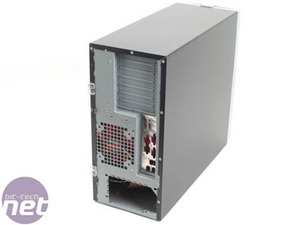
There is a bit of good news here though, in that the case is wide open to modding potential and the matt black surface of the case, which scratches very easily, is really begging for the touch of an airbrush or a Dremel.
The idea of a hydraulic door will also possibly inspire some designers and modders out there who can imagine some cool tweaks for it. We already have a few ideas of our own and the lack of branding anywhere on the case means that treating the X1 as a blank canvas is a very reasonable approach.
Underneath the door, the X1 has room for three 5.25" drives and a single 3.5", which isn't exactly plentiful when compared to some cases but in reality is probably more than enough for most gamers who need two optical drives and little else.
The side of the case features three grills for ventilation, one hexagonal and the other two rectangular, on the right hand side of the case. Unusually, it's the right panel that is removable and provides access to the case's innards and not the left hand panel which is what most PC enthusiasts are used to.
Finally, before moving on to the cases insides, we checked the overall build quality of the X1. We were already a bit dismayed to find that the finish scratched off easily, with brushes from my manly bracelet leaving faint marks, and the lightness of the case had us wary, but we thought best to make sure.
The case, which stands on plastic feet, actually held up okay to a bit of rough treatment. Flicking and fiddling with the power button (something fast becoming known as 'The Martin Test') is always a good indicator of structural integrity and the X1 held up fine in this regard. We were very impressed to discover though that, although the case isn't fantastically designed, it is at least well built and structurally sound.
One thing we did notice though was that the case doesn't have a reset button anywhere – which is going to be an immediate pain for gamers whose systems may be particularly crash prone.
The idea of a hydraulic door will also possibly inspire some designers and modders out there who can imagine some cool tweaks for it. We already have a few ideas of our own and the lack of branding anywhere on the case means that treating the X1 as a blank canvas is a very reasonable approach.
Underneath the door, the X1 has room for three 5.25" drives and a single 3.5", which isn't exactly plentiful when compared to some cases but in reality is probably more than enough for most gamers who need two optical drives and little else.
The side of the case features three grills for ventilation, one hexagonal and the other two rectangular, on the right hand side of the case. Unusually, it's the right panel that is removable and provides access to the case's innards and not the left hand panel which is what most PC enthusiasts are used to.
Finally, before moving on to the cases insides, we checked the overall build quality of the X1. We were already a bit dismayed to find that the finish scratched off easily, with brushes from my manly bracelet leaving faint marks, and the lightness of the case had us wary, but we thought best to make sure.
The case, which stands on plastic feet, actually held up okay to a bit of rough treatment. Flicking and fiddling with the power button (something fast becoming known as 'The Martin Test') is always a good indicator of structural integrity and the X1 held up fine in this regard. We were very impressed to discover though that, although the case isn't fantastically designed, it is at least well built and structurally sound.
One thing we did notice though was that the case doesn't have a reset button anywhere – which is going to be an immediate pain for gamers whose systems may be particularly crash prone.

MSI MPG Velox 100R Chassis Review
October 14 2021 | 15:04












Want to comment? Please log in.